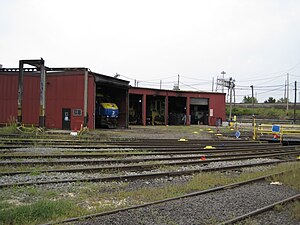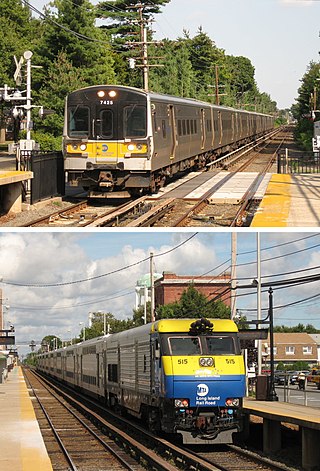
The Long Island Rail Road, often abbreviated as the LIRR, is a railroad in the southeastern part of the U.S. state of New York, stretching from Manhattan to the eastern tip of Suffolk County on Long Island. The railroad currently operates a public commuter rail service, with its freight operations contracted to the New York and Atlantic Railway. With an average weekday ridership of 354,800 passengers in 2016, it is the busiest commuter railroad in North America. It is also one of the world's few commuter systems that runs 24/7 year-round. It is publicly owned by the Metropolitan Transportation Authority, which refers to it as MTA Long Island Rail Road. In 2022, the system had a ridership of 70,342,700, or about 253,800 per weekday as of the third quarter of 2023.
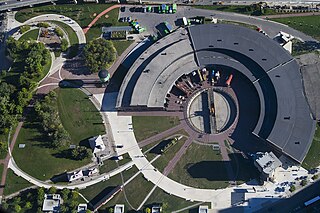
A railway roundhouse is a building with a circular or semicircular shape used by railways for servicing and storing locomotives. Traditionally, though not always the case today, these buildings surrounded or were adjacent to a turntable.
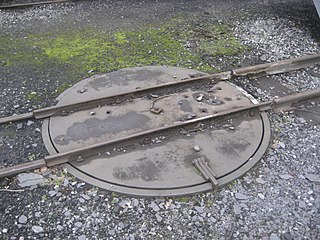
In rail terminology, a railway turntable or wheelhouse is a device for turning railway rolling stock, usually locomotives, so that they can be moved back in the direction from which they came. it is especially used in areas where economic considerations or a lack of sufficient space have served to weigh against the construction of a turnaround wye. In the case of steam locomotives, railways needed a way to turn the locomotives around for return trips as their controls were often not configured for extended periods of running in reverse and in many locomotives the top speed was lower in reverse motion. In the case of diesel locomotives, though most can be operated in either direction, they are treated as having "front ends" and "rear ends". When a diesel locomotive is operated as a single unit, the railway company often prefers, or requires, that it be run "front end" first. When operated as part of a multiple unit locomotive consist, the locomotives can be arranged so that the consist can be operated "front end first" no matter which direction the consist is pointed. Turntables were also used to turn observation cars so that their windowed lounge ends faced toward the rear of the train.

The Montauk Branch is a rail line owned and operated by the Long Island Rail Road in the U.S. state of New York. The line runs the length of Long Island, 115 miles (185 km) from Long Island City to Montauk. However, in LIRR maps and schedules for public use, the term Montauk Branch refers to the line east of Babylon; service from Jamaica to Babylon is covered by separate Babylon Branch schedules, while the line west of Jamaica is currently unused for passenger service. Some Montauk Branch trains operate via the Main Line and Central Branch west of Babylon.

The Ronkonkoma Branch is a rail service operated by the Long Island Rail Road (LIRR) in the U.S. state of New York. On LIRR maps and printed schedules, the "Ronkonkoma Branch" includes trains running along the railroad's Main Line from Hicksville to Ronkonkoma, and between Ronkonkoma and the Main Line's eastern terminus at Greenport. The section of the Main Line east of Ronkonkoma is not electrified and is referred to as the Greenport Branch.

The Long Island City station is a rail terminal of the Long Island Rail Road in the Hunters Point and Long Island City neighborhoods of Queens, New York City. Located within the City Terminal Zone at Borden Avenue and Second Street, it is the westernmost LIRR station in Queens and the end of both the Main Line and Montauk Branch. The station consists of one passenger platform located at ground level and is wheelchair accessible.
The Long Island Rail Road is a railroad owned by the Metropolitan Transportation Authority in the U.S. state of New York. It is the oldest United States railroad still operating under its original name and charter. It consolidated several other companies in the late 19th century. The Pennsylvania Railroad owned the Long Island Rail Road for the majority of the 20th century and sold it to the State in 1966.
The Long Island Rail Road owns an electric fleet of 132 M9, 836 M7, and 170 M3 electric multiple unit cars, and a diesel and diesel-electric fleet consisting of 134 C3 bilevel rail cars powered by 24 DE30AC diesel-electric locomotives and 20 DM30AC dual-mode locomotives.

Greenport is the terminus of the Main Line of the Long Island Rail Road. It is officially located at Wiggins Street and Fourth Street in the Village of Greenport, New York, although the property spans as far east as 3rd Street and the Shelter Island North Ferry terminal.
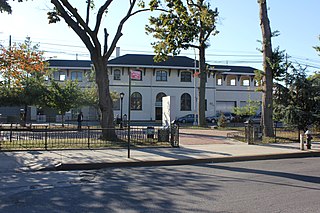
Queens Village is a station on the Long Island Rail Road's Main Line, located between 218th Street and Springfield Boulevard, in the Queens Village neighborhood of Queens, New York City. It has two side platforms along the four-track line, and is served by Hempstead Branch trains. Just east of the station is Queens Interlocking, a universal interlocking that splits the four-track line into two parallel two-track lines—the Main Line and Hempstead Branch—and controls the junction with the spur to Belmont Park. The station is elevated and the tracks leading in and out are on raised ground and only above the road at intersections.
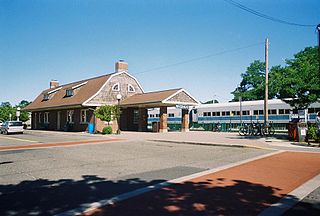
Riverhead is a station along the Main Line of the Long Island Rail Road. It is located on Osborne Avenue and Railroad Street in Riverhead, New York, north of NY 25 and the Suffolk County Court House.

The Georgia State Railroad Museum is a museum in Savannah, Georgia located at a historic Central of Georgia Railway site. It includes parts of the Central of Georgia Railway: Savannah Shops and Terminal Facilities National Historic Landmark District. The complex is considered the most complete antebellum railroad complex in the United States. The museum, located at 655 Louisville Road, is part of a historic district included in the National Register of Historic Places.
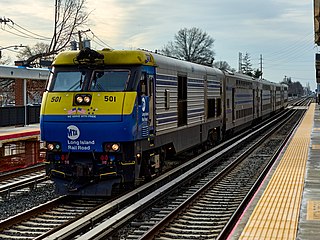
The EMD DE30AC and DM30AC are a class of 46 locomotives built between 1997–1999 by Electro-Motive Division in the Super Steel Plant in Schenectady, New York, for the Long Island Rail Road of the Metropolitan Transportation Authority (MTA) in New York. Originally divided equally between the two types, the fleet currently consists of 24 DE30AC locomotives and 20 DM30AC locomotives.
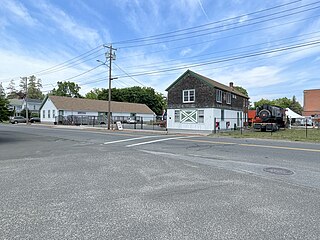
The Railroad Museum of Long Island is a railway museum based on the North Fork, of Long Island, New York, in the United States. It has two locations, the main location in Riverhead, and a satellite location in Greenport, west of the North Ferry to Shelter Island. Both facilities contain active model railroad displays and gift shops.
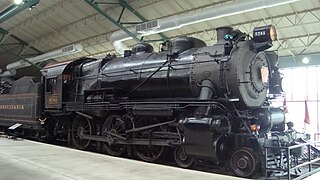
The Pennsylvania Railroad G5 is a class of 4-6-0 steam locomotives built by the PRR's Juniata Shops in the mid-late 1920s. It was designed for passenger trains, particularly on commuter lines, and became a fixture on suburban railroads until the mid-1950s. The G5 was the largest and most powerful 4-6-0 locomotive, except for a single Southern Pacific 4-6-0 that outweighed it by 5,500 lb.
There were a number of engine sheds and railway works located in York. The large York North engine shed became the National Railway Museum in 1975.
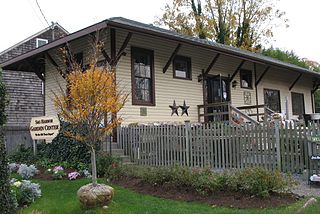
Sag Harbor was the terminus of the abandoned Sag Harbor Branch of the Long Island Rail Road, and was one of two stations within the village of Sag Harbor, New York. It opened in 1870 with the arrival of the LIRR into Sag Harbor, and was the eastern terminus of the LIRR on the south fork of Long Island until 1895, when the Brooklyn and Montauk Railroad built a line from Bridgehampton to Montauk, thus converting the line into a spur north of Bridgehampton. Besides the standard passenger station, it also contained a freight house, and "express building," two yards, a spur to "Long Wharf" which was owned by the LIRR affiliated Montauk Steamboat Company, a coal trestle, a turntable, and a three-story grain storage building owned by The station was rebuilt in 1909 in a manner similar to such stations as Riverhead, Bay Shore, Manhasset, and Bayside stations, among others. During World War I, it was used to transport torpedoes to Long Wharf in order to test them. It was abandoned in 1939 along with the branch. Today, Long Wharf is Suffolk County Road 81, and the former freight house became the Sag Harbor Garden Center's retail store until February 1, 2022, when renovations began to transform to building into Kidd Squid Brewing Company's flagship tasting room, which opened in July 2022 and continues in operation today.

Broadmeadow Locomotive Depot was a large locomotive depot consisting of two roundhouse buildings and associated facilities constructed by the New South Wales Government Railways adjacent to the marshalling yard on the Main Northern line at Broadmeadow. Construction of the locomotive depot at Broadmeadow commenced in 1923 to replace the existing crowded loco sheds at Woodville Junction at Hamilton, with the depot opening in March 1924. It was added to the New South Wales State Heritage Register on 2 April 1999.

The Montauk Cutoff is an abandoned railway in Long Island City, Queens, New York City, that connected the Long Island Rail Road's Main Line and Lower Montauk Branch.
